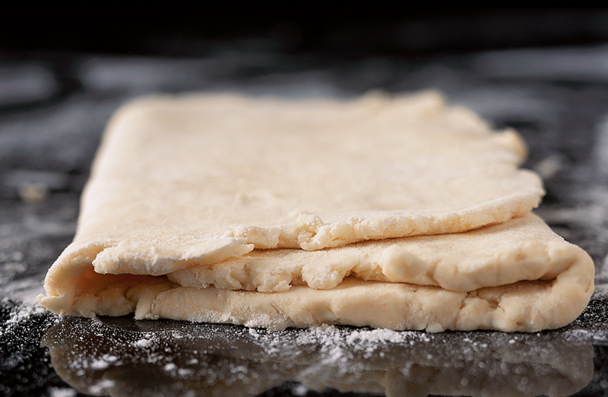Puff pastry is one of the wonders of the baker's art. The time invested in kneading, folding, beating, and rolling the silky dough transforms simple ingredients into buttery, flaky, golden-brown layers that are a point of pride among amateurs and professionals alike. Making the jump from store-bought to homemade can be daunting, so read on for the insider's guide to reaching puff pastry nirvana in your own home.
1. The Big, Buttery Picture
Puff pastry is composed of two main elements: a dough layer (detrempe) and a butter layer (beurrage). The basic technique, known as lamination, involves rolling and folding the detrempe around the beurrage to create countless alternating thin layers. When the resulting dough is baked, the water content in the melting butter evaporates, creating steam. The steam fluffs up the dough, producing the puffy, delicate layers for which this pastry is named.
2. Five-Ingredient Fix
Puff pastry is composed of five key ingredients: flour, butter, water, sugar, and salt. To make 2 1/2 pounds of puff pastry, enough for two 11-inch tarts or several dozen cheese twists, first make the detrempe by combining 12 ounces of all-purpose flour with 4 ounces cake flour in a large bowl. (Note: Measuring flour by weight, using a kitchen scale, is more accurate than measuring by volume.) Rub together the flour mixture with 4 ounces of softened unsalted butter, using your fingers to thoroughly incorporate the butter into the flour. In a separate small bowl, whisk together 1 cup cold water with 1 1/2 teaspoons sugar and 1 1/2 teaspoons salt. Add the water mixture to the flour-butter mixture and work it together with your hands to form a shaggy dough, which will appear ropey and uneven rather than smoothly combined.
To make the beurrage, sprinkle your work surface (preferably any surface other than wood, which retains too much humidity) with 2 ounces of all-purpose flour and then place 1 pound of cold unsalted butter atop the flour. Use a rolling pin to firmly beat the butter, flattening it until it is just soft enough to roll. Roll out the butter to form a 6-inch square measuring approximately 1 inch thick.
To assemble your puff pastry package, press the detrempe into a square that is approximately 1 inch thick. Roll out the four corners of the detrempe into flaps that are about 1/4 inch thick and that stretch 8 to 10 inches away from the center. Add the beurrage to the center of the dough and fold the four flaps over the butter to enclose it, pinching together any holes where the butter peeks through.
3. Avoiding a Sticky Situation
Now it's time to prepare your work surface for rolling and shaping the puff pastry. Less is more when it comes to flouring the surface to keep the dough from sticking. The dough, especially when slightly warm, will absorb any flour it comes into contact with, and excess flour will make the dough dry and tough as well as more likely to burn in the oven.
For the best results, scrape underneath the entire length of the dough with a large offset spatula after every few rolls with the rolling pin. This will loosen and shift the dough and reduce the risk of sticking or tearing, while ensuring an even thickness and minimizing the need for flouring.
4. Rolling in the Deep
With your package of butter and dough assembled, and your work surface properly prepped, it's time to start the rolling and folding process that will create the countless flaky layers. It's important to note that the colder your kitchen is, the better, as the butter will inevitably melt quickly.
Begin by pressing your rolling pin firmly into the dough and rolling back and forth to flatten it out into a smooth rectangle that is approximately twice as long as it is wide and roughly 1/8 inch thick. Next, fold the dough rectangle over itself by choosing between a single fold (similar to a letter that's folded in three parts) and a double fold (such that the ends are folded halfway in, and then the halves are folded once again). Double folds create more layers; however, double-folded dough is more difficult to manage since it is twice as thick.
Rotate the folded package of dough 90 degrees and roll it out until it is roughly 1/2 inch thick. Repeat the rolling, folding, and rotating process six times if doing a single fold, and four times if doing a double fold. Whether you're single- or double-folding, wrap the dough securely in plastic wrap and let it rest in the refrigerator for a minimum of one hour after every two folds, which leads me to…



 Pinterest
Pinterest


